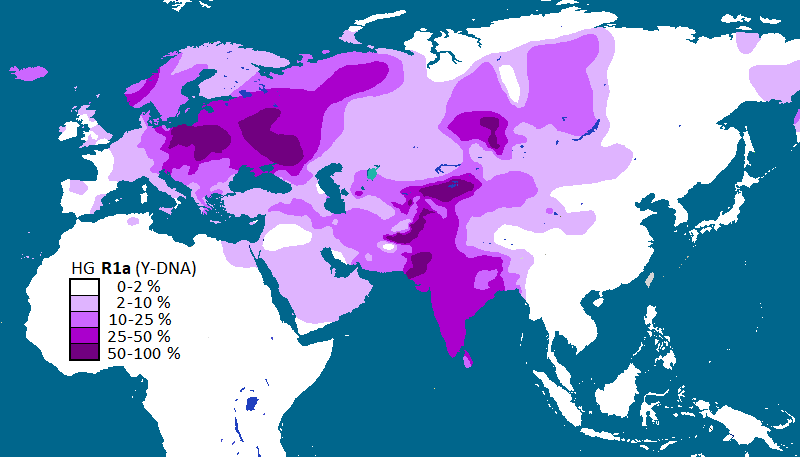Y-DNA Haplogroup R1a Distribution Map


Alex Cartwright
Senior Cartographer & GIS Specialist
Alex Cartwright is a renowned cartographer and geographic information systems specialist with over 15 years of experience in spatial analysis and data...
Geographic Analysis
What This Map Shows
The "Distribution of Y-DNA haplogroup R1a across Eurasia" map visually represents the geographical spread of haplogroup R1a, a significant lineage in human genetics. This haplogroup, derived from the Y chromosome, is of particular interest to geneticists and anthropologists as it provides insights into human migration patterns and population genetics. The visualization highlights areas where R1a is prevalent, ranging from Eastern Europe to Central and South Asia, showcasing the complex tapestry of human ancestry across these regions.
Deep Dive into Y-DNA Haplogroup R1a
Haplogroup R1a is one of the most studied Y-DNA haplogroups, primarily due to its remarkable distribution across Eurasia and its implications for understanding ancient human migrations. Geneticists believe that R1a originated in the region around the Ural Mountains and has since spread widely, particularly among Indo-European populations. This haplogroup is often associated with the early migrations of these groups, leading to significant cultural and linguistic developments.
R1a can be divided into several subclades, with R1a1a being particularly noteworthy. This subclade is prevalent in Slavic populations and has historical ties to the spread of the Kurgan culture, which played a crucial role in the dissemination of Indo-European languages. Interestingly, recent studies suggest that R1a's presence can also be traced back to ancient pastoralist societies in the Eurasian steppes, highlighting the importance of mobility in the development of human populations.
Statistically, R1a is found in over 30% of the male populations in regions like Poland, Ukraine, and Russia, demonstrating its significant genetic footprint. Moreover, its presence in South Asia, particularly among certain ethnic groups in India, showcases the complexity of human migration and intermingling throughout history. This haplogroup has even been linked to historical figures and events, as genealogical research continues to uncover the connections between genetics and ancestry.
Regional Analysis
Looking at the map, we can see distinct regional variations in the distribution of haplogroup R1a. In Eastern Europe, for instance, countries like Poland and Ukraine show high frequencies of R1a, often above 30%. This prevalence correlates with the historical movements of Slavic peoples, and studies have indicated that these populations have retained a significant portion of their genetic heritage over centuries.
Moving towards Central Asia, countries such as Kazakhstan exhibit a lower frequency of R1a, which can be attributed to the region's diverse demographic history, influenced by both the Silk Road and the Mongol invasions. Interestingly, while R1a is less common in countries like Kazakhstan, it still plays a role in understanding the genetic makeup of various ethnic groups, particularly among the Kazakh and Uighur populations.
In South Asia, the presence of R1a is more complex. Certain groups, especially among Brahmins and Kshatriyas, exhibit a higher prevalence of this haplogroup, suggesting a historical connection to the Indo-Aryan migrations. However, the frequency varies greatly among different castes and regions, indicative of the intricate social structures and historical migrations within the subcontinent.
Significance and Impact
Understanding the distribution of Y-DNA haplogroup R1a is not just an academic exercise; it has real-world implications. The genetic data can illuminate historical migration patterns, helping to reconstruct the movement of peoples over centuries. Moreover, as genetic testing becomes more accessible, individuals are increasingly interested in their ancestral roots, often tracing back to these haplogroups.
Furthermore, this knowledge can also play a role in public health. Certain diseases and genetic traits are associated with specific haplogroups, and understanding these connections can lead to better healthcare strategies tailored to specific populations. As we continue to uncover the links between genetics, history, and culture, the significance of haplogroup R1a will only grow, providing a deeper understanding of human identity and our shared past.
In conclusion, the map of Y-DNA haplogroup R1a distribution serves as a compelling tool for both researchers and enthusiasts alike. It encapsulates the journey of human populations across vast landscapes, revealing the connections that bind us through genetics, history, and culture. Have you ever wondered how your own ancestry might connect to this ancient lineage? The answers may be closer than you think.
Visualization Details
- Published
- October 23, 2025
- Views
- 8
Comments
Loading comments...